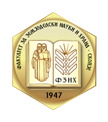ASSIMILATION OF NUTRIENTS FROM COMMON WHEAT (TRITICUM AESTIVUM L.) DEPENDING ON SOME AGRONOMY FACTORS
Keywords:
Wheat, mineral fertilization, uptake, nutrients.Abstract
The genotype specificity in the uptake of the main nutrients according to the fertilization rate was investigated in Triticum aestivum L. varieties under conditions of a vegetation experiment. Four fertilization rates were tested: N0P0K0, N200P200K200, N400P200K200 and N600P200K200. The response of the varieties to the nutrition conditions provided was studied during several stages of growth and development. The different nutrition regimes used lead to manifestation of the specific abilities of the varieties to take up nutrients. Genotype and mineral fertilization had a higher effect on nutrients uptake than stage of development. During the initial stage of wheat development, the differences established in the uptake of macro elements were greater between the varieties than between the individual fertilization rates. The differences were most evident at maturation. This specificity was well expressed in nitrogen and phosphorus uptake in total biomass and to a lesser extends - in potassium uptake. Varieties Slaveya and Milena had highest amounts of nitrogen uptake in grain.
References
Anderson, W.K.,Van Burgel, A.J., Sharma, A.J., Shakcley, B. J., Zaicou-Kunesch, C.M., Miyan, M.S. and Amjad, M., (2011). Assessing specific agronomic response of wheat cultivars in a winter rainfall environment, Crop & Pasture Science, 62: 115-124.
Clark, R.B. (1990). Physiology of cereals for mineral nutrient uptake, use and efficiency, Academic Press, San Diego, California, USA, 234-245.
Dimova, D., Rachovska, G., and Ganuscheva, G.,(2002). Characteristics of the new wheat lines selected, Plant science, 5-6: 255-261.
Hagos, H.G. and Abay, F., (2013). AMMI and GGE Biplot analysis of bread wheat genotypes in the Northern part of Ethiopia, J. Plant Breed. Genet, 1: 12-18.
Ivanov, P., Djendova, R., and Dikova, P., (1993). Genotypic specificity in nitrogen feeding 13 varieties of winter wheat, Soil science, agricultural chemistry and ecology, 4: 7-12.
Klimaschevskii, L. (1990). Theory agrochemical efficiency of plants, Agrochemicals, 1: 131-145.
Klimaschevskii, L. (1991). Genetic aspects of mineral nutrition of plants, Agropromizdat, Moscow.
Le Gouis, J., Beghin, D., Heumez, E., and Pluchard, P., (2000). Genetic differences for nitrogen uptake and nitrogen utilization efficiencies in winter wheat, European Journal of Agronomy, 12, 3-4: 163-173.
Misas, J., Kostadinova, Sv. and Тomov, Т, (2003). Absorption and distribution of nitrogen, phosphorus and potassium in wheat variety Prelom, Soil Science, Agro-chemistry and ecology, 1: 24-27.
Nankova, M., (1994). Seed N-content and its relation to some nitrogen metabolism elements in common wheat cultivar Pryaspa, XXIVth Annual meeting of ESNA, September 12-16, Varna.
Nankova, M., Kostov, K. and Penchev, E., (1999). Genetic variations in the dynamics of dry matter accumulation, nitrogen assimilation and translocation in new T. aestivum L. varieties. II. Nitrogen assimilation and translocation in relation to grain yield and protein content, XXIXth Annual meeting of ESNA, October.
Tsenov N. and Atanasova, D., (2013a). Influence of environments on the amount and stability of grain yield in today‘s winter wheat cultivars, I. Interaction and degree of variability, Agricultural Science and Technology, 5:153-159.
Yagdi, K. (2009). Path coefficient analysis of some yield components in durum wheat (Triticum durum Desf,), Pak. J. Botany, 41: 745-751.
Zadoks, J. C., Chang, T. T. and Zonzak, C. F., (1974). A decimal code for the growth stages of cereal, Weed Res, 14: 415-421.



